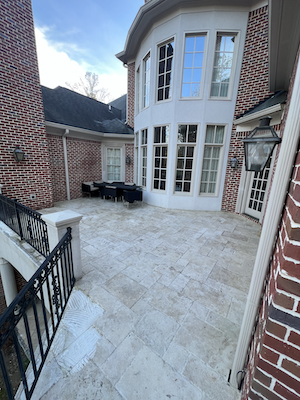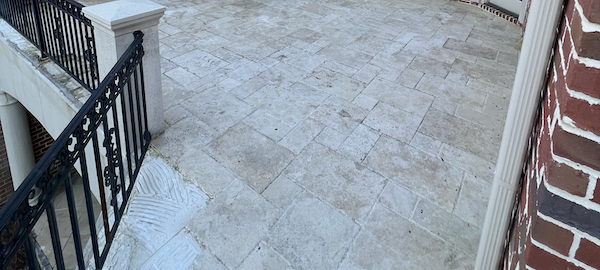QUESTION

What is your best recommendation for membrane for a uncovered deck on concrete please? The picture attached is one part of it. I’d like to help my customers save money, but do it the way it should be.
ANSWER
I appreciate you reaching out to the NTCA Technical Team with your question regarding your exterior balcony project. I am glad you have recognized the complexity of this project and are asking questions before starting this job.
An exterior balcony over occupied space is among the most critical types of installations a tile contractor can face. There is a lot of information to consider, more than can be addressed here, so I will begin by listing the applicable reference materials and suggest you take a look through the information listed below:
TCNA Handbook (2022 Edition)
- Natural Stone tile selection and installation guide (Page 10 – 14)
- Membrane selection guide (Page 22 – 23)
- Wet Areas Guidelines (Page 44)
- Environmental Exposure Classifications (Page 47). See the definition for Res6 (Residential Exterior) and the charts for Floors and Walls (Pages 48, 49 and 50)
- Methods for Exterior Roof/Deck and Balcony/Deck Floors: F103; F103B; F104; F105 (Pages 64-71)
- Methods for Exterior Walls: W201 (Page 364); W202E (Page 366); W244E (Page 368)
- EJ171 Movement Joint Guidelines for Ceramic, Glass, and Stone (Page 434)
- Appendix B. Estimated Weights For Floor Installations (Page 448) Can the current structure support the additional weight of adding the proper amount of slope?
When reviewing the TCNA Handbook methods for Exterior Roof/Deck and Balcony/Deck Floors that I’ve listed above, please make note of this statement in the “Preparation By Other Trades” section: “Roof drains and membrane by other trades – provide completed drainage at roof membrane level by use of weep holes as shown or other methods.”
Regarding movement joints, please note that the “Movement Joint” section states: “…architect must specify type of joint and show location and details on drawings” and Method EJ171 states: “Because of the limitless conditions and structural systems on which tile can be installed, the design professional or engineer shall show the specific location and details of movement joints on project drawings.”
ANSI A108/A118/A136 (November 2021 Release date)
There are multiple sections in A108 and A118 that pertain to exterior and wet area installations, movement joints, thick bed system requirements, etc.
NTCA Reference Manual (2022/2023 Edition)
- Prerequisites and Considerations for Successful Balconies, Courtyards, Patios, Plaza Decks, Roofs, Exterior Walking Surfaces and Swimming Pool Decks (Pages 170 – 171)
The section I’ve noted in the NTCA Reference Manual is extremely informational – please read it first. At the end of that section you will read this: “DISCLAIMER: The tile contractor is not responsible for the design of the system. To avoid potential liabilities, use a general contractor and certified roofing contractor when waterproofing over occupied living space.”
There is no simple product recommendation or set of instructions or solution I can offer. The best advice I can give you is to:
- Follow the guidance of the NTCA Reference Manual and the TCNA Handbook which recommend employing a general contractor, architect, structural engineer as needed to properly design and specify the structural support; mechanical (drainage) systems; movement/expansion details; waterproofing system and other elements of this very complex installation.
- Hire a roofing contractor and mechanical contractor to install the primary roofing membrane and the mechanical/drain-waste-vent system.
- Ensure considerations are made for any railings/balusters to not puncture the primary waterproofing layer unless they can be adequately sealed.
- Ensure all of the waterproofing and membranes are flashed onto the walls and, since the walls are being tiled, are fully waterproofed, or the water managed as outlined in the wall methods I’ve listed.
- After the project has been engineered and designed by structural and mechanical professionals, contact and involve setting material and membrane manufacturers that will assist you in product selection and ask them to provide you with detailed installation instructions for their products and a written system warranty that covers their products in this installation.
- Follow all manufacturer instructions and guidelines in the TCNA Handbook, ANSI A108 and the NTCA Reference Manual.
- Clearly communicate the complexity of this project to the homeowner and inform them what it will take to ensure their project is a success.
I know I just gave you a lot of information but this is a complex project that involves a lot of consideration to avoid future risk of failure. The amount of risk you/your business takes on is something that needs to be considered as well.







